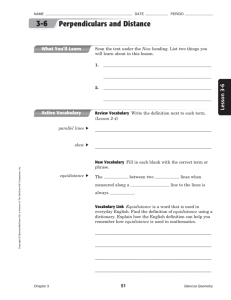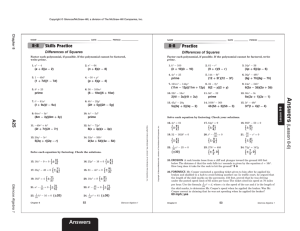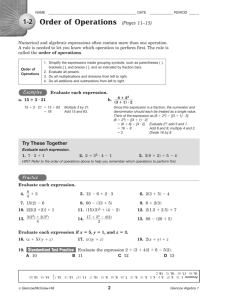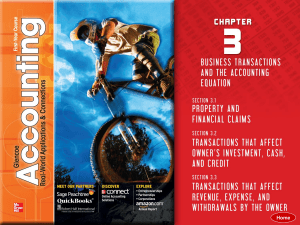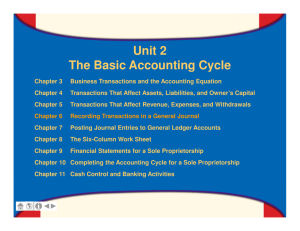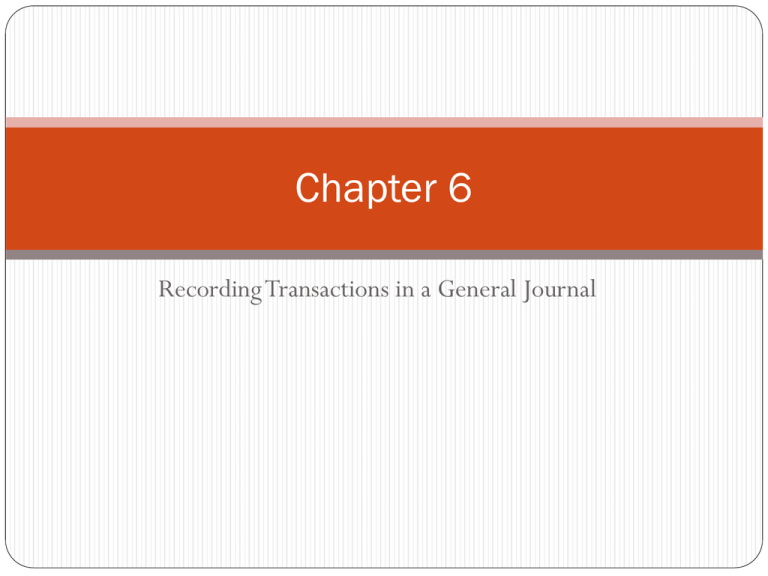
Chapter 6
Recording Transactions in a General Journal
SECTION 6.1
The Accounting Cycle
The Steps of the Accounting Cycle
The accounting cycle, the activities a business undertakes to
keep its accounting records in an orderly fashion, consists of nine
steps. This chapter will cover steps 1, 2, and 3:
Collect and verify source documents.
Analyze each transaction.
Journalize each transaction.
Glencoe Accounting Unit 2 Chapter 6 Copyright © by
The McGraw-Hill Companies, Inc. All rights reserved.
The Steps of the Accounting Cycle
Glencoe Accounting Unit 2 Chapter 6 Copyright © by
The McGraw-Hill Companies, Inc. All rights reserved.
The First Step in the Accounting Cycle:
Collecting and Verifying Source Documents
A business has several transactions that take place daily. A
source document is created for each business transaction.
Commonly used source documents are:
an invoice
a receipt
a memorandum
a check stub
Glencoe Accounting Unit 2 Chapter 6 Copyright © by
The McGraw-Hill Companies, Inc. All rights reserved.
The Second Step in the Accounting Cycle:
Analyzing Business Transactions
Determine the debit and credit portions of each transaction by
analyzing the source document. In the real world, you must
examine this document to determine what happened in a business
transaction.
Glencoe Accounting Unit 2 Chapter 6 Copyright © by
The McGraw-Hill Companies, Inc. All rights reserved.
The Third Step in the Accounting Cycle:
Recording Business Transactions in a Journal
Now the complete details of each transaction must be
entered in a journal, a record of the transactions of a
business. This is called journalizing.
A journal can also be called the book of original entry.
Glencoe Accounting Unit 2 Chapter 6 Copyright © by
The McGraw-Hill Companies, Inc. All rights reserved.
The Accounting Period
The accounting period is the length of time that accounting
records cover. A 12 month period is called a fiscal year. If
the fiscal year spans from January 1 to December 31, it is a
calendar year.
SECTION 6.2
Recording Transactions in the General Journal
Recording a General Journal Entry
The most common accounting journal is the general journal, in which all of the
transactions of a business may be recorded. The general journal has two columns:
the left column for recording debits
the right column for recording credits
Glencoe Accounting Unit 2
Chapter 6 Copyright © by The
McGraw-Hill Companies, Inc. All
rights reserved.
Recording a General Journal Entry
This is an example of a general journal entry:
Glencoe Accounting Unit 2
Chapter 6 Copyright © by The
McGraw-Hill Companies, Inc. All
rights reserved.
Recording a General Journal Entry
There are seven steps to determining each journal entry:
Identify the accounts affected.
Classify the accounts affected.
Determine the amount of increase or decrease for each
account affected.
Determine which accounts are debited and for what
amount.
Determine which accounts are credited and for what
amount.
Determine the complete entry in T-account form.
Determine the complete entry in general journal entry
Glencoe Accounting Unit 2
form.
Chapter 6 Copyright © by The
McGraw-Hill Companies, Inc. All
rights reserved.
Recording a General Journal Entry
Here is an example showing the analysis of a business
transaction and its general journal entry:
Glencoe Accounting Unit 2
Chapter 6 Copyright © by The
McGraw-Hill Companies, Inc. All
rights reserved.
Correcting the General Journal
If an error is found, it must be corrected.
Do not erase an error. Draw a line through it with a pen and
enter the correct information above the line.
Glencoe Accounting Unit 2
Chapter 6 Copyright © by The
McGraw-Hill Companies, Inc. All
rights reserved.


